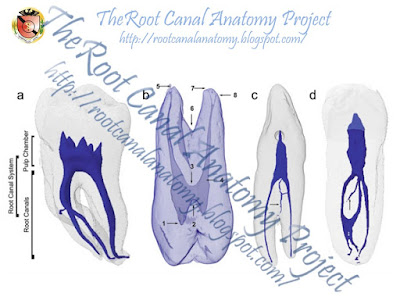Middle mesial canals in mandibular first molars:
a micro-CT study in different populations
Marco Aurélio Versiani, Ronald Ordinola-Zapata, Ali Keleş, Hatice Alcin,
Clóvis Monteiro Bramante, Jesus Djalma Pécora, Manoel Damião Sousa-Neto
Objective
To describe the morphological aspects of middle mesial canals (MMC) in mandibular first molars using micro-CT.
Design
Mandibular first molars collected from the Brazilian (n=136) and Turkish (n=122) populations were scanned (voxel size: 9.9 μm) and mesial roots with MMC (n=48) evaluated regarding several morphological aspects. The incidence of MMC in each population was statistically compared using Chi-square test (α=0.05).
Results
Overall, the incidence of MMC was 18.6% (48 out of 258 molars) and was significantly higher in the Brazilian (n=30; 22.1%) than in the Turkish (n=18; 14.8%) population (p<0.05). In both populations, confluent configuration of the MMC was the most frequent anatomy. Most of the specimens with MMC had 3 independent orifices (n=26; 54.2%) and 3 apical foramina (n=21; 43.8%). The mean minor diameter of the MMC orifice (0.16 mm) was 3 times less than the other orifices (∼0.50 mm). In mesial roots with independent configuration (n=3; 6.3%), the mean volumes (mm3) of the MMC, mesiobuccal (MBC) and mesiolingual (MLC) canals were 0.20±0.10, 0.75±0.28, and 0.88±0.19, respectively. In the specimens with canal confluence (n=26; 54.2%), MMC merged to the MBC (n=8; 16.7%), MLC (n=4; 8.3%), or to both MBC and MLC (n=14; 29.2%). Double mesial canal was observed in only 1 specimen. MMC with an independent foramen was observed mostly in Brazilian specimens.
Conclusions
Incidence of MMC was higher in the Brazilian molars. Confluent configuration was the most revalent anatomic variation, while independent and fin configurations, as well as, double MMC, were found only in a few specimens.
Keywords
mandibular molar; middle mesial canal; micro-CT; root canal anatomy
Click HERE or HERE to read and download the article in full


























































